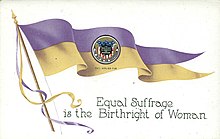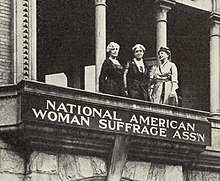 | |
 Gardener, Park and Catt at Suffrage House in Washington, D.C. | |
| Abbreviation | NAWSA |
|---|---|
| Predecessor | Merging of the National Woman Suffrage Association and the American Woman Suffrage Association |
| Successor | League of Women Voters |
| Formation | 1890 |
| Dissolved | 1920 |
Key people | Susan B. Anthony, Elizabeth Cady Stanton, Carrie Chapman Catt, Lucy Stone |
The National American Woman Suffrage Association (NAWSA) was an organization formed on February 18, 1890, to advocate in favor of women's suffrage in the United States. It was created by the merger of two existing organizations, the National Woman Suffrage Association (NWSA) and the American Woman Suffrage Association (AWSA). Its membership, which was about seven thousand at the time it was formed, eventually increased to two million, making it the largest voluntary organization in the nation. It played a pivotal role in the passing of the Nineteenth Amendment to the United States Constitution, which in 1920 guaranteed women's right to vote.
Susan B. Anthony, a long-time leader in the suffrage movement, was the dominant figure in the newly formed NAWSA. Carrie Chapman Catt, who became president after Anthony retired in 1900, implemented a strategy of recruiting wealthy members of the rapidly growing women's club movement, whose time, money and experience could help build the suffrage movement. Anna Howard Shaw's term in office, which began in 1904, saw strong growth in the organization's membership and public approval.
After the Senate decisively rejected the proposed women's suffrage amendment to the U.S. Constitution in 1887, the suffrage movement had concentrated most of its efforts on state suffrage campaigns. In 1910 Alice Paul joined the NAWSA and played a major role in reviving interest in the national amendment. After continuing conflicts with the NAWSA leadership over tactics, Paul created a rival organization, the National Woman's Party.
When Catt again became president in 1915, the NAWSA adopted her plan to centralize the organization, and work toward the suffrage amendment as its primary goal. This was done despite opposition from Southern members who believed that a federal amendment would erode states' rights. With its large membership and the increasing number of women voters in states where suffrage had already been achieved, the NAWSA began to operate more as a political pressure group than an educational group. It won additional sympathy for the suffrage cause by actively cooperating with the war effort during World War I. On February 14, 1920, several months prior to the ratification of the Nineteenth Amendment, the NAWSA transformed itself into the League of Women Voters, which is still active.